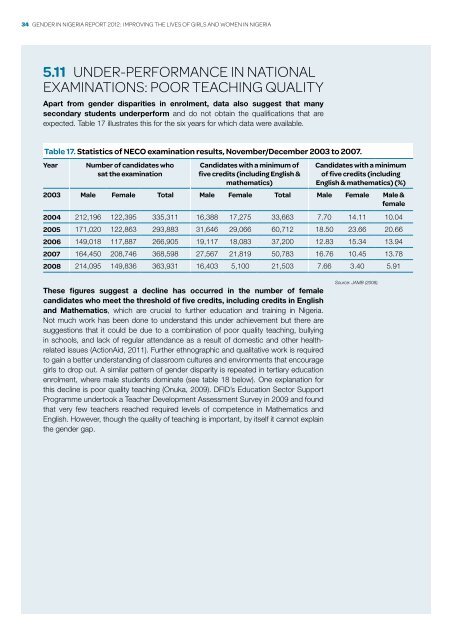Gender in niGeria report 2012 - Economic Commission for Africa
Gender in niGeria report 2012 - Economic Commission for Africa
Gender in niGeria report 2012 - Economic Commission for Africa
Create successful ePaper yourself
Turn your PDF publications into a flip-book with our unique Google optimized e-Paper software.
34 <strong>Gender</strong> <strong>in</strong> Nigeria Report <strong>2012</strong>: Improv<strong>in</strong>g the Lives of Girls and Women <strong>in</strong> Nigeria<br />
5.11 Under-per<strong>for</strong>mance <strong>in</strong> national<br />
exam<strong>in</strong>ations: poor teach<strong>in</strong>g quality<br />
Apart from gender disparities <strong>in</strong> enrolment, data also suggest that many<br />
secondary students underper<strong>for</strong>m and do not obta<strong>in</strong> the qualifications that are<br />
expected. Table 17 illustrates this <strong>for</strong> the six years <strong>for</strong> which data were available.<br />
Table 17. Statistics of NECO exam<strong>in</strong>ation results, November/December 2003 to 2007.<br />
Year<br />
Number of candidates who<br />
sat the exam<strong>in</strong>ation<br />
Candidates with a m<strong>in</strong>imum of<br />
five credits (<strong>in</strong>clud<strong>in</strong>g English &<br />
mathematics)<br />
Candidates with a m<strong>in</strong>imum<br />
of five credits (<strong>in</strong>clud<strong>in</strong>g<br />
English & mathematics) (%)<br />
2003 Male Female Total Male Female Total Male Female Male &<br />
female<br />
2004 212,196 122,395 335,311 16,388 17,275 33,663 7.70 14.11 10.04<br />
2005 171,020 122,863 293,883 31,646 29,066 60,712 18.50 23.66 20.66<br />
2006 149,018 117,887 266,905 19,117 18,083 37,200 12.83 15.34 13.94<br />
2007 164,450 208,746 368,598 27,567 21,819 50,783 16.76 10.45 13.78<br />
2008 214,095 149,836 363,931 16,403 5,100 21,503 7.66 3.40 5.91<br />
These figures suggest a decl<strong>in</strong>e has occurred <strong>in</strong> the number of female<br />
candidates who meet the threshold of five credits, <strong>in</strong>clud<strong>in</strong>g credits <strong>in</strong> English<br />
and Mathematics, which are crucial to further education and tra<strong>in</strong><strong>in</strong>g <strong>in</strong> Nigeria.<br />
Not much work has been done to understand this under achievement but there are<br />
suggestions that it could be due to a comb<strong>in</strong>ation of poor quality teach<strong>in</strong>g, bully<strong>in</strong>g<br />
<strong>in</strong> schools, and lack of regular attendance as a result of domestic and other healthrelated<br />
issues (ActionAid, 2011). Further ethnographic and qualitative work is required<br />
to ga<strong>in</strong> a better understand<strong>in</strong>g of classroom cultures and environments that encourage<br />
girls to drop out. A similar pattern of gender disparity is repeated <strong>in</strong> tertiary education<br />
enrolment, where male students dom<strong>in</strong>ate (see table 18 below). One explanation <strong>for</strong><br />
this decl<strong>in</strong>e is poor quality teach<strong>in</strong>g (Onuka, 2009). DFID’s Education Sector Support<br />
Programme undertook a Teacher Development Assessment Survey <strong>in</strong> 2009 and found<br />
that very few teachers reached required levels of competence <strong>in</strong> Mathematics and<br />
English. However, though the quality of teach<strong>in</strong>g is important, by itself it cannot expla<strong>in</strong><br />
the gender gap.<br />
Source: JAMB (2008).

















